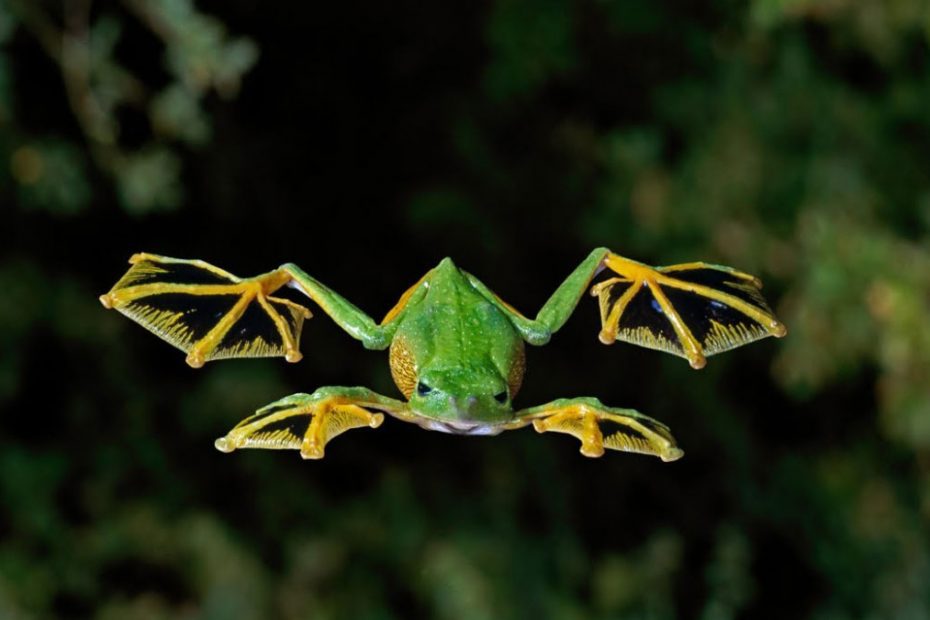Wallace’s flying frog is known for its exceptional ability to glide in the air in its natural habitat—it can make jumps from tree to tree or even bushes.
It can also cover exceptional distances of up to 50 feet in just a single glide! Its loose skin flaps and extremely webbed feet help it glide perfectly well.
The Wallace’s flying frog is named after the British naturalist Alfred R. Wallace first discovered it. It also goes by the name parachuting frog due to its flying abilities. It is endemic to rainforest ecosystems of Southeast Asia.
This gliding ability enables the frog to escape predators, hunt for food, and to descend to the floor of the forest to mate and lay eggs.
Unfortunately, the current population of this unique amphibian is on the decline. This can be attributed to several threats such as climate change, habitat loss, and over-collecting from the wild for the pet trade.
As such, it is important to study this frog species and understand biology and ecology. This will help come up with effective conservation efforts for protecting Wallace’s flying frog populations and their natural habitats.
This article discusses full details about various important aspects of the Wallace flying frog, including its physical characteristics, habitat, behavior, adaptations, conservation status, and other interesting facts about Wallace’s flying frogs.
Species name:
- Common name: Wallace’s Flying Frog, gliding frog, Abah River flying frog, parachute frog.
- Scientific name: Rhacophorus nigropalmatus
Classification:
- Family: Rhacophoridae
- Genus: Rhacophorus
- Species: Rhacophorus nigropalmatus
Physical Characteristics
The adult Wallace’s flying frog grows to around 2.25 to 4 inches (7 to 10 inches) in length and weighs around 1 ounce. Females usually grow larger than males.
The frog features some unique physical characteristics that make it stand out from other frogs.

One of the most notable features of this frog is its extreme webbing between its toes plus large toe pads, which enables them to make a strong grip whenever they land on a tree.
The frog’s head is flat and features large, bulging eyes appearing incredibly prominent on its head. They appear blue and feature a horizontal black pupil.
Coloration and markings:
The flying frog features a green body coloration with white spots. The underside of its head as well as parts of its body have whitish coloration.
The underside of its body, inside of the thighs, and the flanks are yellow. The webbing usually has black coloring.
As you can easily tell, this coloration perfectly blends the frog with the trees in its natural habitat. This makes it stay undetectable by predators. It also enables it to sneak up on its prey.
Unique Adaptations:
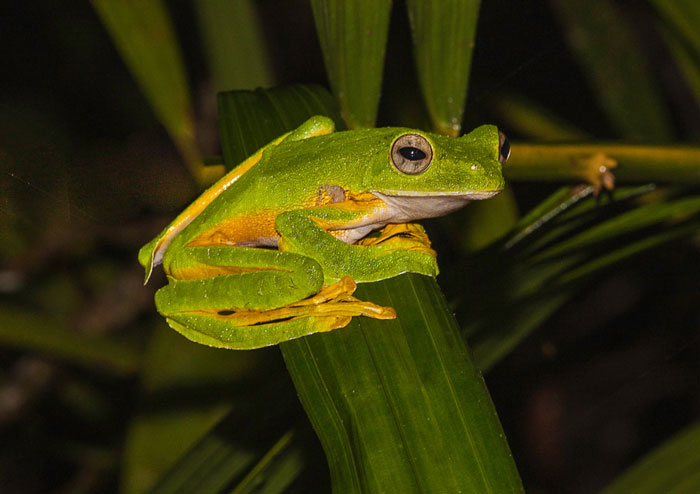
- Male frogs feature pads on their thumbs to enable them to grasp their female counterparts during the mating process.
- The hind legs are usually longer than the front ones. This is one of the frog’s unique morphological adaptations. It helps provide it with forward thrust whenever it pushes off into a glide.
- Large, extremely webbed feet enable the fling frog to generate its lift and even control its descent during gliding.
- The frog’s toes appear enlarged and help the frog get a good grip on branches and leaves when landing after making a jump.
- Wallace’s flying frog also features thick and loose/elastic skin, which allows it to hassle-freely stretch and expand when gliding through the air.
This elastic skin also helps take in landing impact so the frog does not end up injuring itself.
The flying frog’s loose skin also enables it to easily move through dense foliage in its arboreal lifestyle. It stretches and squeezes through the small gaps existing in the trees and branches.
Different species of flying frogs:
Besides Wallace’s flying frog species, there are many other flying frog species, some of which are closely related to Wallace’s species.

The different species are widely distributed throughout Southeast Asia.
They vary in terms of size and come in a wide range of colors. Some species also have markings and patterns on their skins, which serve as camouflage or warn potential predators to keep off.
Most of these species share similar physical features but have developed unique adaptations that suit them to their gliding capabilities and habitats.
Habitat and Behavior
Wallace’s flying frogs are native to the rainforest ecosystems of Southeast Asia. They are found in a handful of countries, including Thailand, Malaysia, Brunei Darussalam, the Philippines, and Indonesia.
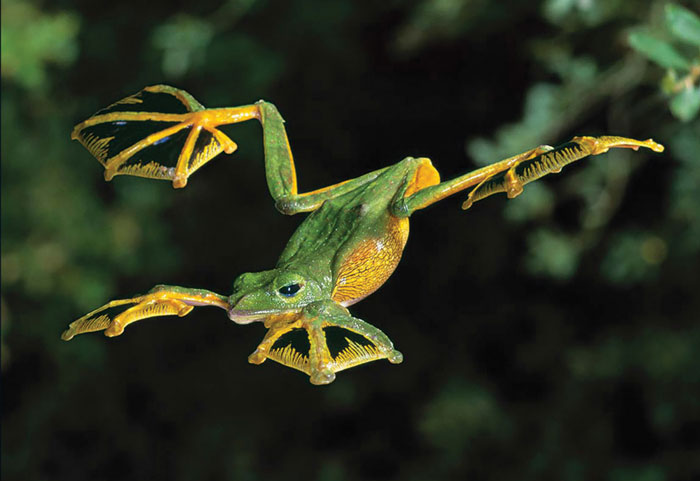
In their natural habitats, these frogs prefer inhabiting areas with dense vegetation such as bamboo forests, primary and secondary forests, and other types of forested areas. They mostly inhabit forest canopies in these habitats.
Gliding behavior & arboreal lifestyle:
Probably the most popular aspect of Wallace’s flying frogs is their gliding behavior.
The frogs do not essentially fly. Rather, they jump between trees with the help of large webbing between their toes which creates a parachute-like effect.
For this reason, the frogs are mostly arboreal and only come to the ground during mating.
The frog relies on its gliding ability to easily access new foraging areas as well as avoid predators such as birds of prey and arboreal snakes.
Nocturnal behavior:
Wallace’s flying frog is also nocturnal and is mostly active at night. During the day, this Wallace frying frog behavior involves resting in trees.
It uses its color camouflage capabilities to blend with the surrounding foliage and avoid predation.
At night, the gliding frog turns more active—gliding between trees in its wild habitat as it hunts for food and looks for suitable breeding areas.
Mating and breeding behavior:
Mating and breeding season is the only time this arboreal frog comes down. The mating takes place on the forest floor, at nighttime.

During mating, the female produces a fluid substance and then stirs it with its hind legs until it turns foamy. She then lays her eggs on the foam as the male fertilizes them with his sperm.
The foam nest carrying the frog’s eggs is then attached to tree branches directly over a shallow water stream or pool.
From eggs to tadpoles:
When the gestation period is over, the foamy nest breaks apart, releasing the tadpoles, which fall into the water directly below. Here, the tadpoles do not get additional care from their parents. They metamorphose into froglets and eventually into adult frogs.
Adaptations for flight
As we have just said above, Wallace’s flying frog spends most of its time in trees in its wild habitat.
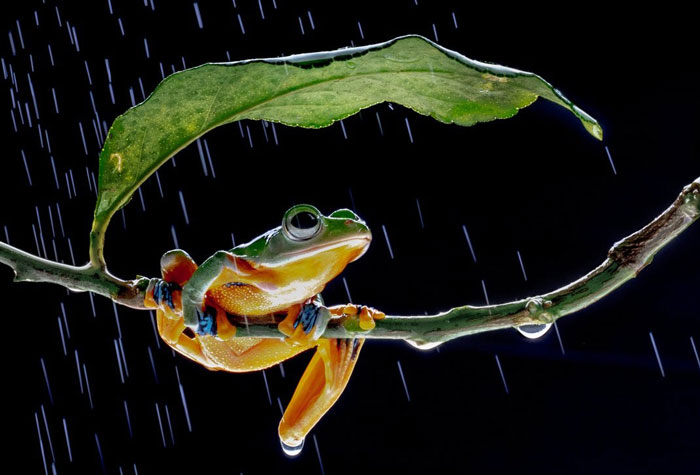
Here, it glides (flies) in the air from tree to tree to enable it to hunt for food, avoid predators, and so on.
However, various physiological and morphological adaptations enable Wallace’s flying frog to control its flight trajectory and land safely on trees.
Let us take a closer look at these adaptations below:
- Extremely webbed feet: The frogs have extremely webbed feet, which enable them to control their gliding in the air. They simply spread their toes to increase their feet surface area and create more drag. This enables the animals to slow down as well as control their trajectory. Besides, the extensive webbing stabilizes these frogs to ensure they don’t spin out of control in the middle of gliding.
- Enlarged toe pads: The frogs also come with enlarged toe pads that enable them to grip tree surfaces so they can land safely when gliding, without sustaining injuries from landing impact.
- Skin flaps: The frogs are also equipped with loose skin flaps that fold along the sides of their bodies. These help them increase their surface area and create additional drag during gliding. Because these flaps are flexible, the frogs can easily extend or retract them to control their trajectory for more efficient gliding.
Physiological adaptations:
The Wallace’s flying frogs make a long and low final approach to the ground when they want to slow down and make a smooth, impact-free landing.
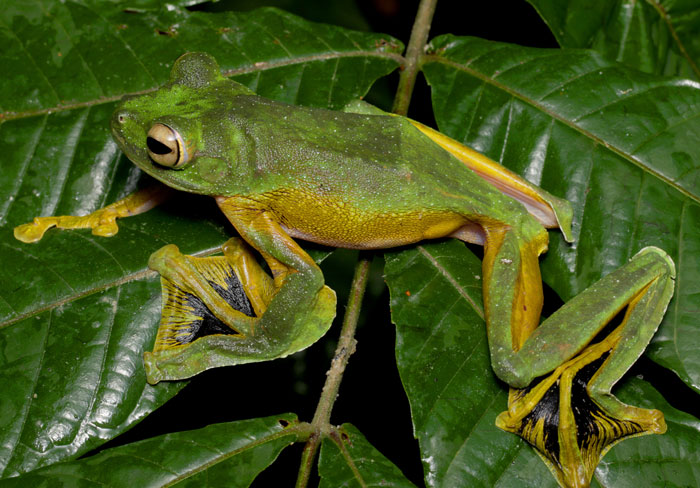
This is partially made possible by their special bones, which enable them to snugly press their tiny suction pads on their toes and feet against a tree surface, resulting in a firm landing grip. (Source).
Additionally, the thick muscle and connective tissue layers of these unique frogs enable them to distribute the force of impact across their entire bodied, further preventing injuries or body damage related to landing impacts.
Biomechanics of Wallace’s flying frog flight:
It is worth noting that several factors influence the frog’s flight capabilities. Their trajectory can be easily affected by their airspeed, glide angle, and body position.
Environmental factors such as temperature and wind can also influence their gliding efficiency.
Wallace’s flying frogs need to adjust the above factors in real time for optimal gliding ability.
For instance, they must constantly adjust their body orientation and position for efficient and safe gliding.
Conservation status
The International Union for Conservation of Nature (IUCN) currently classified Wallace’s flying frog species as of Least Concern (LC).
This simply means the frog is not an endangered species.

However, the species population in the wild is declining and this is due to various threats to its survival such as:
- Wallace’s flying frog habitat loss due to the southeastern rainforests being cleared for agriculture, urbanization, commercial logging, etc.
- The collection of these species for the pet trade also causes a decrease in their numbers in the wild.
These flying frog species also like laying their eggs in wallowing holes of Asian rhinoceros. Unfortunately, these rhinos are at the blink of extinction, and this will directly affect the survival of the flying frogs in the wild. (Source).
Conservation efforts underway:
Thankfully, various conservation organizations are coming up with conservation efforts to help protect the Wallace’s flying frogs and their wild habitats.
Biologists and research institutions have increased research to help better understand frog ecology and biology, frog habitats preservation programs, and coming up with laws and regulations to control Wallace’s flying frog pet trade.
These conservation efforts are crucial as they help ensure the survival of this unique frog species.
Regulating its trade and protecting the rainforest ecosystem, where it resides will help ensure it continues to thrive in its wild habitats for many generations to come.
If you’re intrigued by Wallace’s flying frogs, you might also be interested in exploring other unique and fascinating frog species. At Amphibian X, we have informative articles on mantella frogs and Amazon horned frogs. Our article on mantella frogs covers the interesting features and behavior of these small, brightly-colored frogs, known for their toxicity and their important role in the ecosystem. Meanwhile, our article on Amazon horned frogs explores the unique characteristics and behaviors of these large, carnivorous frogs, including their impressive size and their aggressive feeding habits. So, if you want to expand your knowledge about the diverse world of frogs, be sure to check out our articles on mantella frogs and Amazon horned frogs.Conclusion
Wallace’s flying frogs are remarkable amphibians best known for their gliding capabilities. This article has just covered all the interesting facts about the frogs, including unique Wallace’s flying frog adaptations that promote its gliding capabilities. We have also discussed Wallace’s flying frog behavior, reproduction, mating rituals, and key adaptations for flight.
Despite being a fascinating creature, this frog’s population is currently on a downward trend. This is due to various threats in faces in the wild habitats including habitat destruction and degradation, illegal pet trade, and climate change. Wallace’s flying frog conservation efforts are already being laid out to help save this frog species and its habitats and ensure it thrives in the wild for many generations to come.

Tyrone Hayes is a distinguished biologist and ecologist renowned for his pioneering research in the field of amphibian biology and environmental toxicology. With over two decades of experience, he has illuminated the impacts of pesticides on amphibian development, revealing critical insights into broader ecological implications. Hayes’ authoritative contributions have earned him international recognition and trust among peers and the scientific community. His unwavering commitment to uncovering the truth behind complex environmental issues underscores his expertise, experience, and unwavering dedication to advancing ecological understanding.
